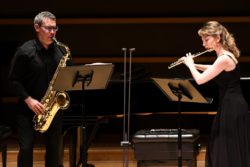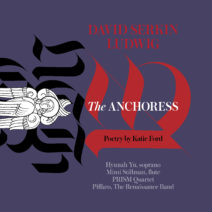LINER NOTES
The Living Grave, Illuminated
The medieval anchoress cuts a paradoxical figure: Buried alive, she is sought out for her wisdom. Encased in perpetual darkness, she is considered clairvoyant. Dead to the world, she becomes a pillar of her community.
During the Early and High Middle Ages, hundreds of women volunteered for a life of extreme deprivation as anchoresses, mystics bricked up in a cells attached to a churches. In each anchorhold, a tiny window, known as a “squint,” opened onto the sanctuary so that the anchoress could take part in the Eucharist. Another opened onto the outside world. Villagers and sometimes even senior clerics would come to that window to consult her on spiritual questions. There were male anchorites, too, but at the height of the practice women outnumbered them four to one.
Compared to the other choices – wife, nun, servant, prostitute – the life of a recluse demanded acute sacrifice, but promised in return a level of safety few common-born women enjoyed. The anchorhold protected her from sexual assault, pestilence, and the dangers of pregnancy and childbirth. And it offered respect, and a certain autonomy. Some anchoresses wielded considerable influence as is evident from the number of texts – written by men – that warned against excessive pride, sociability, or independence of thought. The perfect anchorite life, wrote one author, was lived “in silence, in secret, in darkness.”
For the poet Katie Ford, these contradictions become a point of entry into the inner life of an anchoress who is by turns contemplative and bitter, mystical and shrewd. We listen in on conversations she has at her window, follow her mind as it roams through a landscape of memory, and experience with her pangs of terror, doubt and religious ecstasy. In certain places, Ford inserts artful redactions, like passages in a manuscript rendered illegible by censorship or time.
In David Ludwig’s setting, the words of Ford’s Anchoress take flight in a flock of voices – all performed by a single soprano who employs a spectrum of vocal techniques, from whispers and the sing-speak style called Sprechstimme to lyrical outpourings and wordless vocalise. Ludwig also gives his Anchoress a doppelgänger in the shape of a solo recorder. Sometimes it hovers about the female voice, or cuts in like a shard of sunlight strafing the cell. On occasion, the recorder seems to take flight – the embodiment of a soul that cannot be confined.
The recorder is part of an ensemble of Renaissance-period instruments that adds idiomatic color to Ludwig’s score. They share space, incongruously, with a quartet of saxophones who take on a variety of guises. When quoting the 14th-century composer Machaut, the saxophones blend together into a soft incense haze. In combination with the recorders, shawms and sackbuts they can create unruly sonorities of gnomish exuberance, like the medieval science fiction of Hieronymus Bosch.
In fact, the work is structured in painterly vignettes more than in movements, each one bathed in a particular light and mood. In the opening scene we hear the instrumentalists intone the Requiem over stern chords repeated as in a processional. The dark funerary music marks the death of the Anchoress’s earthly life and her entrance into the living grave of her cell.
Subsequent scenes evoke a beehive of questions, a nightmarish excursion through dangerous woods; the bubble and murmur of secular life on the other side of thick walls. Where the Anchoress’s words are obliterated in Ford’s poem, the saxophones create a violent scribble of noise, an eruption of sonic vandalism, part growl, part metal. In the fifth movement, the composer writes in “twelve seconds of chaos,” a carefully choreographed scramble of frantic strumming, muffled shouts and asynchronous flurries of saxophone scales.
Against such outbursts, prayerful passages like the one that concludes the work unfold with startling radiance. While Ludwig’s harmonies won’t brook any glib resolution, they suggest a female form of embodied spirituality that, even bereft of illusions, finds illumination.
“Three Anchoress Songs” for flute and tenor saxophone was written during the gestation period of “The Anchoress.” Here, too, are echoes of Machaut and sound painting evoking extremes of light and darkness, movement and bricked-in stasis. The second song features a flutter of saxophone runs in which the sound pales until only the clip-clap of the instrument’s keys are audible, like the frantic movements of a bird trapped in a snug room. The final song, for piccolo and saxophone, expands in a mode of dreamy lyricism, with the piccolo tracing gleaming arabesques in space shadowed by the saxophone. It ends with the two performers quietly singing Machaut’s rondeau “Doulz viaire gracious.” After the unconfined wordless ruminations by the two instruments, the unexpected appearance of human language feels like an intrusion on a deeply intimate communion with the divine.
Corinna da Fonseca-Wollheim






